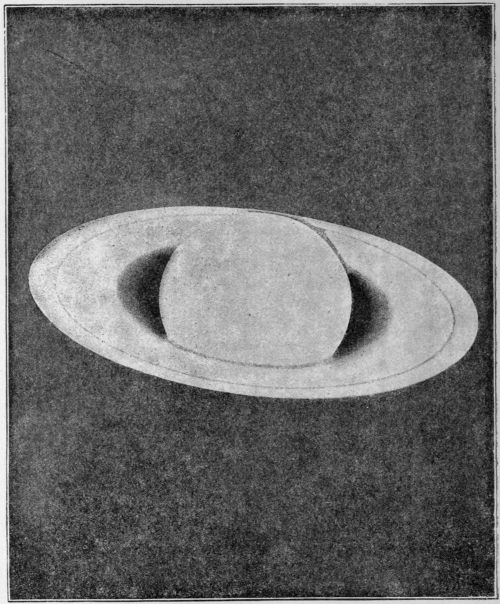
THE
STORY OF THE
SOLAR SYSTEM
BY
GEORGE F. CHAMBERS, F.R.A.S.
OF THE INNER TEMPLE, BARRISTER-AT-LAW
AUTHOR OF THE STORY OF THE STARS

WITH TWENTY-EIGHT ILLUSTRATIONS
NEW YORK
McCLURE, PHILLIPS & CO.
MCMIV
Copyright, 1895,
By D. APPLETON AND COMPANY.

Fig. 1.—The Planet Saturn.
PREFACE.
Having in my “Story of the Stars” told offar distant suns, many of them probably withplanets revolving around them, I have in thepresent volume, which is a companion to theformer one, to treat of the Sun in particular—ourSun as we may call him—and the body of attendantswhich own his sway by revolving round him.The attendants are the planets, commonly socalled, together with a certain number of comets.I shall deal with all these objects rather from adescriptive and practical than from a speculativeor essay point of view, and with special referenceto the convenience and opportunities of personspossessing, or having access to, what may becalled popular telescopes—telescopes say of fromtwo to four inches of aperture, and costing anysum between £10 and £50. There is muchpleasure and profit to be got out of telescopes ofthis type, always presuming that they are used bypersons possessed of patience and perseverance.It is a very great mistake, though an extremelycommon one, to suppose that unless a man cancommand a big telescope he can do no useful4work, and derive no pleasure from his work. Toall such croakers I always point as a moral theachievements of Hermann Goldschmidt, who froman attic window at Fontenay-aux-Roses nearParis, with a telescope of only 2½ inches aperture,discovered no fewer than 14 minor planets.
As this volume is intended for general reading,rather than for educational or technical purposes,I have kept statistical details and numericalexpressions within very narrow limits, merefigures being always more or less unattractive.
John Richard Green, in the Preface to hisbook on The Making of England, writes as follows:—“Imay add, in explanation of the reappearanceof a few passages ... which myreaders may have seen before, that where I hadlittle or nothing to add or to change, I have preferredto insert a passage from previous work,with the requisite connections and references, tothe affectation of rewriting such a passage for themere sake of giving it an air of novelty.” I willventure to adopt this thought as my own, and toapply it to the repetition, here and there, of ideasand phrases which are already to be found in myHandbook of Astronomy.
G. F. C.
Northfield Grange,
Eastbourne, 1895.